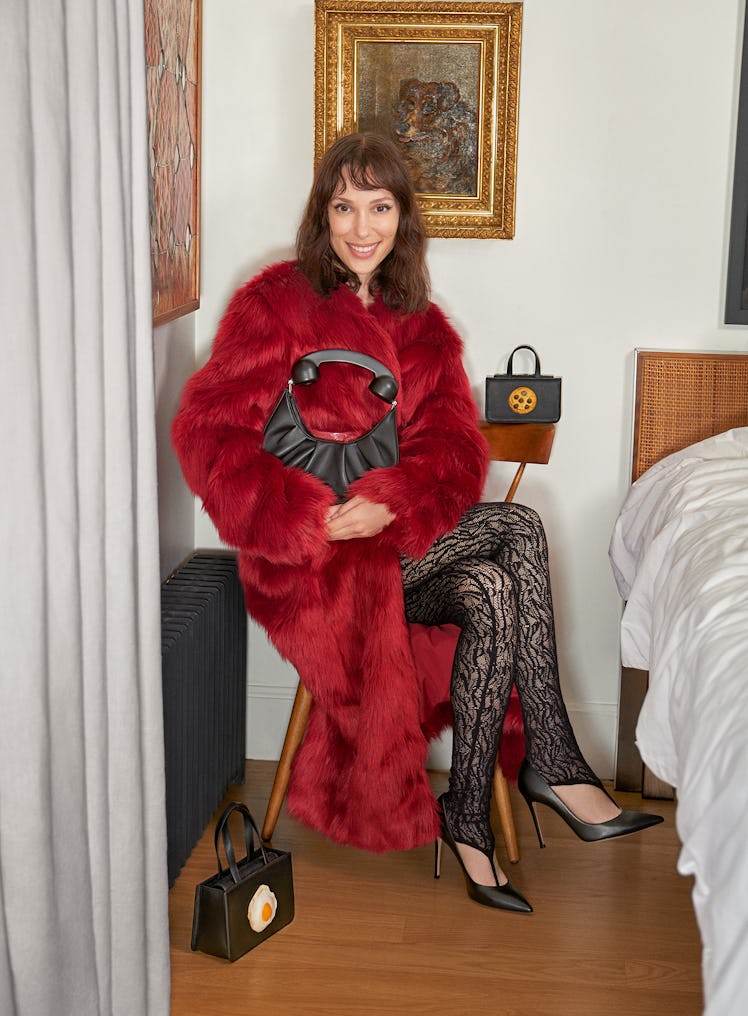Puppets and Puppets Founder Carly Mark Wants to Keep Fashion Funny

For W’s annual The Originals portfolio, we asked creatives—pioneers in the fields of art, music, food, dance, fashion and more—to share their insights on staying true to themselves. See this year’s full class of creatives here.
Before you started your brand, Puppets and Puppets, you were an artist. A lot of your work revolved around candy and snacks. Now your brand’s most iconic piece is a bag embellished with a resin chocolate chip cookie. Why do you think you gravitate toward food as a source of inspiration?
I first moved to New York when I was 18, and I was this excited but terrified young person walking alone for the first time in a big city. There were bodegas everywhere, which were mystifying to me, having grown up in the suburbs of Detroit. I was just like, What is this weird corner store with bizarre foods from multiple countries, and there’s dust on everything and there’s a cat that lives here? I felt very inspired by everything in those stores. At one point, I was only making Haribo paintings. When I switched to fashion, I had no intention of bringing the food stuff with me. But something that I’ve always really loved to do is disrupt. To me, there was a void in fashion. People weren’t being ridiculous.
I have a cookie bag, and it’s amazing to see how delighted people can be by an accessory.
There’s something so satisfying about a fake yet realistic thing. It’s a conversation starter. The strongest response is always from TSA agents at the airport. They look at stuff all day long, and then this shows up and they’re like, “What the hell is this?”
You’ve also used fried eggs as a breastplate, bananas as purse handles, and wedges of Swiss cheese as heels on a pair of Mary Janes.
The reason I used a banana was because it’s already a handle. And the reason I use a cheese wedge is because it’s a heel already. I’ve had telephones and little leaping greyhounds as handles, but food works because it is usually one for one in terms of scale.
In the past, you’ve talked about how certain films have been inspirations for your collections.
I feel very moved by film because I’ve always been drawn to escapism. Last season’s collection had elements of film in it, but it was very much about me. It has become very clear that my clothes sell best when I love them. That is not because I am the epitome of style or anything like that—it’s because humans are drawn to honesty.
Why do you think most designers shy away from incorporating humor into what they do?
There’s a desire in the world, particularly in fashion, to be sexy. I find humor incredibly sexy, but it’s harder to be funny and sexy and make it work. I’m up for that challenge.
Are there any designers or artists whose work you feel relates to what you’re doing?
Elsa Schiaparelli, but also Schiaparelli under Daniel Roseberry. I’m a huge Miguel Adrover fan. I think Maurizio Cattelan is really good at being funny and sexy. Matthew Barney—that’s a funny, sexy guy. Aphex Twin, Björk—funny, but in a dark way.
Were you always interested in fashion?
When I was a child, I would draw little dresses and rip everything out of my closet, put something on for 45 minutes, and then change. Then, when I was older, in 2006, I interned at Marc by Marc Jacobs, and the corporate setting kind of freaked me out. But I think during the 10 years that I was involved in fine art, the New York fashion world started to change. In my mid- to late 20s, I started going to Luar and Vaquera shows and meeting people like Raffaella Hanley, who does Lou Dallas. She studied painting, not fashion, and I thought, This is so exciting, and I can do this too.
Was there a steep learning curve when you first started designing?
There wasn’t a steep learning curve because I didn’t have any interest in learning. My superpower is that I don’t know that I’m doing anything wrong. I want to stay in that ignorant bliss because there is nothing holding me back. My fresh eyes have gotten me to where I am now. The biggest challenge was figuring out the business side of things—that’s really hard.
Having now worked in both the fashion and the art worlds, how would you compare the two?
The art world acts as if art is this transcendental thing. But art’s a product just like any other. And it’s the Wild West of business. The price of an artwork is completely arbitrary. It’s based on a market that is dictated by representation, popularity, whether you’re alive or dead, etc. Whereas fashion says very boldly, “I’m a product.” But actually, to me, it transcends. There is a holiness to clothing: It’s a way to express yourself. It’s a way to relay your insides on your outside. It’s a form of protection, a form of communication. It’s also a method of survival. And in fashion, prices are not arbitrary. Things are expensive because it’s expensive to make them.
Who do you consider an original?
Dracula. Frankenstein. Bunnicula. Werewolves in general. Monsters move through the world as themselves. They don’t have another choice. I can’t think of a monster that isn’t iconic.
Makeup by Akiko Owada for Chanel at The Wall Group; Photo Assistants: Nigel Jones, John Vetromile; Fashion Assistant: Emmalynne Walpole.
This article was originally published on